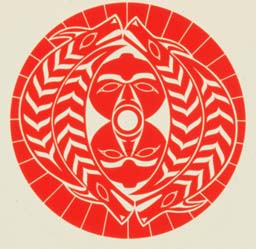 S'cinq' Food of the Thunderbird
S'cinq' Food of the Thunderbird09/81 Susan A. Sparrow
Edition: 28/60 Silkscreen
© Copyright 1981 Susan A. Point. All Rights Reserved.
This image was also derived from a carved spindle whorl. It is interesting to note that while Salish women used spindle whorls to spin yarn from mountain goat wool, it was the responsibility of Salish men to carve them. Thus, in her work, Point is not only redefining a three-dimensional art form in a two-dimensional printed surface, she is also challenging old ideas of gender-based artistic creation. This becomes even more evident as Point's career evolves, and she gains recognition for her ability as a carver of both wood and glass.
Like Man and Sea Otters, this image combines central human figures (just the heads this time) with surrounding animal representations that meet above the figures' heads. The two heads, mirror images of each other, share a central gaping, circular mouth, which again indicates where the spindle whorl would be fitted onto a shaft for use. Here, however, the concentric circles of the composition are interspersed with repeating ellipses, formed by the bodies of the surrounding animal figures. The tension created between the circles and ellipses, all sharing one center, creates a sense of rotating motion. Accentuating this effect are the v-shaped lines on the interior of the animal figures that seem to indicate, like arrows, alternating directions of rotation within the whorl. The radiating lines visible on the periphery serve to pull the entire composition together, linking circles and ellipses within a spinning whole.
Joanne P. Danford mounted a show of Susan Point's prints and the weavings of her niece Krista Point at the Thunder Bay Art Gallery in 1989-1990. She entitled the show "From Periphery to Centre", and used this image on the cover of the accompanying catalogue. The title accurately describes both the recognition and movement of Coast Salish artistic traditions within the public sphere, as well as the pattern of motion within Susan Point's prints. Within this print especially, as your eye travels from the outside edge to the inner circle, you cannot help but be swept along by the curving lines of the repeated forms, moving round and round the image before reaching its center.
